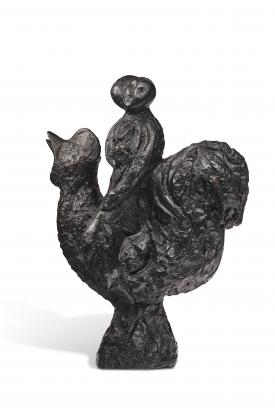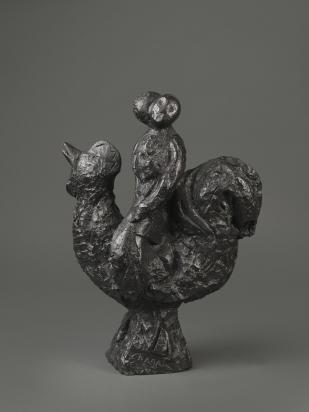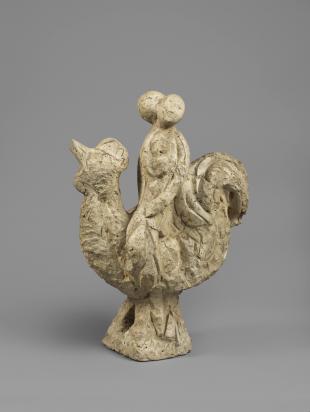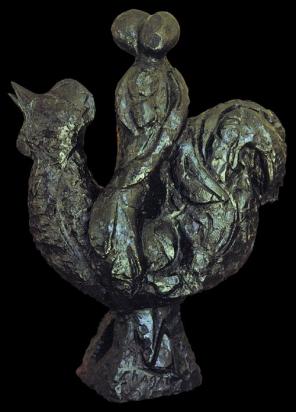Cast from a plaster mold, The Rooster is part of a collection of seven other bronze sculptures by Chagall, cast by the Susse foundry in limited numbers. Transposed as a sculpture, the rooster is an omnipresent pattern in Chagall’s works. It is found in hundreds of the artist’s paintings and drawings—a proliferation that owes a lot to Russian popular art.
Due to its symmetrical composition, featuring a stable base, and to its decorative appearance, The Rooster evokes the ceramic works of central Russian potters, as well as, among others, ceramics from the city of Skopine, in the Ryazan region, and ceramics from Gjel, near Moscow. This design and the same composition were often used to make recipients for cold drinks. The shape of the sculpture, almost rustic with its irregularities and plays of light, doesn’t fail to echo the sculptures and figurines made by Russian artisans using wood shears. It was no accident that Ossip Zadkine, who hailed from the same city as Chagall, appropriated the technique in 1943 for his patina bronze sculpture. Present in many cultures, the rooster is a totemic animal in Russia, where it is associated with the sun, fire, and protective strength. The pair of lovers in an embrace, straddling the rooster, is a recurring theme throughout Chagall’s body of work. Namely, it is found in the celebrated painting on canvas entitled Fiancés of the Eiffel Tower or Bride and Groom With Eiffel Tower [Les Fiancés de la Tour Eiffel ou Les Mariés de la tour Eiffel] (1936 - 1939), in which the gallinaceous bird seems to link the upheavals of the past to a future filled with hope.
Sculpture
The Rooster
(Le Coq)
Keywords:
Related works

Marc CHAGALL, The Rooster (Le Coq), 1959, bronze, 22 7/16 x 15 3/4 x 5 1/2 in. (57 x 40 x 14 cm), Private collection © ADAGP, Paris, 2026

Marc CHAGALL, The Rooster (Le Coq), 1958 - 1959, bronze, 22 1/16 x 16 9/16 x 7 5/16 in. (56 x 42 x 18.5 cm), Private collection © Fabrice GOUSSET/ADAGP, Paris, 2026

Marc CHAGALL, The Rooster (Le Coq), 1952, plaster on metal armature, 22 11/16 x 16 15/16 x 8 1/16 in. (57.7 x 43 x 20.5 cm), Private collection © Fabrice GOUSSET/ADAGP, Paris, 2026
